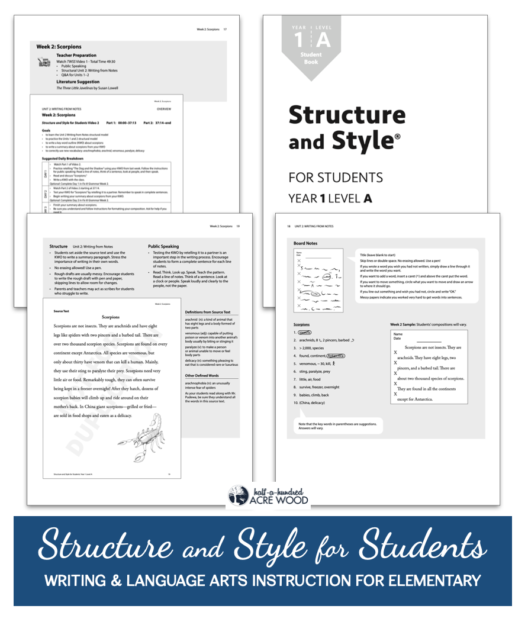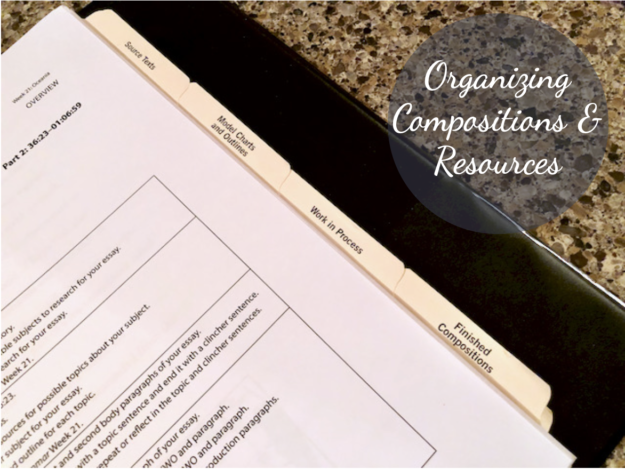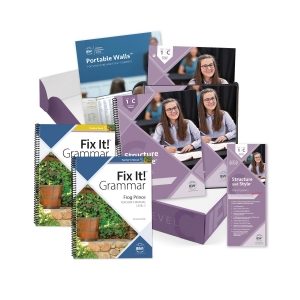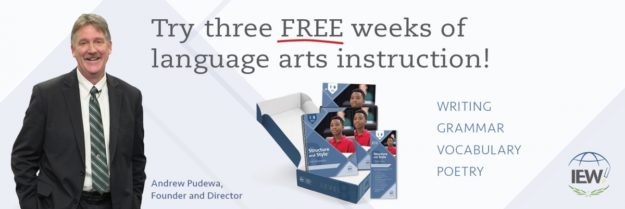Rewind one decade.
As we approached the time when our oldest son needed to learn to write paragraphs and essays, I realized I had no idea how to actually teach writing. Although I could write paragraphs and essays myself, I had virtually no recollection of how I learned that skill. At about that time, I was introduced to a program that teaches parents (and teachers) how to teach writing at all age levels: Teaching Writing Structure and Style. That program provided solid training on teaching nine structural models for composition, along with how to move students towards the mastery of using stylistic techniques, such as varying sentence structure and adding literary devices.
Since then, I’ve taught composition from elementary through high school using theme-based writing lessons which build upon the foundational concepts within this program. But I’ve always hoped to find a thorough, video-based writing program to suggest for parents who prefer to hand over the instruction to another lead teacher. Finally, at the close of last school year, IEW released a video-based curriculum that provides their time-tested video instruction directly to the students: Structure and Style for Students.
Laid out in much the same way as the teacher/parent training, Structure and Style for Students takes students through learning nine different writing structures and several stylistic techniques – with Andrew Pudewa as the teacher. Three levels are available, each consisting of 24 weeks of writing instruction and assignments that can be extended to 30 weeks if desired:
In Structure and Style for Students Year 1 Level A, Andrew Pudewa takes students in Grades 3-5 through seven types of structures: Note-Making and Outlines, Writing from Notes, Retelling Narrative Stories, Summarizing a Reference, Writing from Pictures, Summarizing Multiple References, and Inventive Writing. At this level, students write about a variety of topics from science & history, fables & myths, and geography & personal experiences.
In Structure and Style for Students Year 1 Level B, Pudewa leads students in Grades 6-8 through nine types of structures: Note-Making and Outlines, Writing from Notes, Retelling Narrative Stories, Summarizing a Reference, Writing from Pictures, Summarizing Multiple References, Inventive Writing, Formal Essay Models, and Formal Critique. At this level, students write about more advanced topics from science & history, fables & myths, and geography & personal experiences – and they conduct more in-depth research for longer essays.
In Structure and Style for Students Year 1 Level C, Pudewa increases the challenge and intensity of the program for students in Grades 9-12, covering the same nine structures with a variety of topics while also including university application essays, author/literary analyses, and responses to essay prompts on ethics, current events, and more.
Each level comes with an Adapting the Schedule for 30 Weeks download to schedule the coursework over a longer time period and a Student Samples download to provide examples of student writing for each lesson.
The weekly lessons are laid out in 4 or 5 days to provide flexibility for families who participate in co-ops. Each lesson includes a clear daily lesson breakdown for assignments, including corresponding literature suggestions, new vocabulary words, and detailed lesson plans for parents/teachers to stay plugged in to what their student is learning.
In all levels, Andrew Pudewa leads students through the process of taking key-word-outline notes from source texts and coaches them on how to construct compositions from those notes. The student notebook includes model charts for each unit/structure, and a checklist is provided for the student to confirm that they have completed all of the requirements for the assignment.
This year, our seventh grader has been working in Structure and Style for Students Year 1 Level B. Early on, he asked me to be his editor (a task assigned by Mr. Pudewa) and even provided a letter informing me that I was not to lecture him but to only offer suggested edits on his paper. It has actually been a great break for me, and my son has greatly enjoyed the independence as well. (It’s a win-win!)
The lesson breakdown has helped him with time management, and the emphasis on organizing his papers has been a huge plus. (It’s a relief to not be the only one telling him to be organized with his work!)
Even though Pudewa teaches the class via video, the Teacher’s Manual includes all the notes that were written on the board as well as the instructions/assignments that were given to the students in class.
Unlike some of the theme-based writing, Structure and Style for Students offers a variety of topics from different content areas. Our son has thoroughly enjoyed the variety of topics he’s written about this year, especially the more scientific and peculiar ones. His favorite assignment was on Mike the Headless Chicken. He enjoyed writing this essay so much that he transformed it into a 4-H speech and then modeled his 4-H poster off the same topic.
This will be the first year he qualifies for the 4-H Golden Clover Award, and it’s all because of Mike. (and Mr. Pudewa.) Seriously, I have never been able to motivate him like this particular topic did.
With Pudewa’s engaging, humorous approach to writing and the incremental progression that the Structure and Style method is known for, this program has proven effective in improving my son’s writing. And… as our youngest son has watched his brother’s lessons this year (of his own accord), he’s hoping he will be ready to start his very own Pudewa class using Level A next year as a third grader.
In addition to the Basic Level A, Level B, and Level C packages, IEW also offers a Basic Plus Option for each level which adds Fix It! Grammar to the program – for only $20 more. (Read more about Fix It! Grammar here. It is our favorite resource for teaching grammar to students in grades 2-12.)
There are also premier packages that include the Teaching Writing Structure and Style program if you’d like to also have the teacher training program. However, I believe that if you watch the Structure and Style for Students lessons with your child, you will learn much of what you would learn in the teacher training. Using this program also opens the door to the many different theme-based writing programs offered by IEW because the lessons are similar in structure (and style!).
After completing Year 1 at your student’s grade level, there’s a “Year 2” option for each level so that you can continue honing writing skills for another year at the same general reading level:
- Structure and Style for Students Year 2 Level A
- Structure and Style for Students Year 2 Level B
- Structure and Style for Students Year 2 Level C
And for Level B (Grades 6-8), there’s a Year 3 option!
Although at times we’ve used other programs to focus on poetry, creative writing, and literary analysis, the Structure and Style program (first introduced to us over ten years ago through Teaching Writing Structure and Style) is the default we return to for all grade levels. It is the one program that offers instruction and practice in writing different types of essays, short stories, and other inventive writing prompts that our students may encounter in the future. Our oldest son – now in college – continues to use what he learned in the Structure and Style program to write his scholarship essays and his college-level papers.
Teaching writing is often complicated, confusing, and frustrating, but it doesn’t have to be! This open-and-go program helps to minimize the difficulties and bridges the chasm to inspire students not only to write, but also to become more competent thinkers and more confident communicators.
100% Money-Back Guarantee
Because of IEW’s incredible 100% Money-Back Guarantee, we highly recommend purchasing products directly from IEW instead of through 3rd-party sellers.
Try out Writing, Spelling, Poetry, and Grammar Programs for Free!
We highly recommend checking out the first three weeks of Structure & Style for Students program from IEW. (You can access the first three weeks free.)
Other IEW programs you can try out for free include…
- Structure and Style for Students. If you’d prefer Andrew Pudewa to teach writing structure and style to your student(s), this program is for you! Download the first lessons from each level for teaching composition to children in grades 3-12.
- Fix It! Grammar. Download the first lessons of all four levels of this gentle introduction to grammar and mechanics with thorough yet simple instructions for the teacher.
- Introduction to Public Speaking. Download the first two lessons of this engaging program for learning to conquer the #1 fear of most people: public speaking.
- University-Ready Writing is a 12-week video-based course which teaches high school students advanced note-taking skills and writing techniques in preparation for college-level writing. Try it free here!
- Theme-Based Writing Lessons. Theme-Based Writing Lessons are for students and/or teachers familiar with IEW’s Structure and Style Program. Topics include science, history, literature, and Bible, covering a variety of grade levels.
- Linguistic Development through Poetry Memorization. Download the first five poems from this mastery approach to learning poetry.
- The Phonetic Zoo. Try a sample of a program that teaches spelling with an auditory approach towards mastery. (Requires free registration.)
- Free audio talks, booklists, and more! (Our favorite audio is Nurturing Competent Communicators.)
Visit IEW to find out more about other programs to transform your students into proficient writers – from early elementary all the way through college! You may also be interested in our favorite resources for teaching grammar and composition to students in grades 3-12.
*IEW product images are subject to copyright. Used with permission.




















